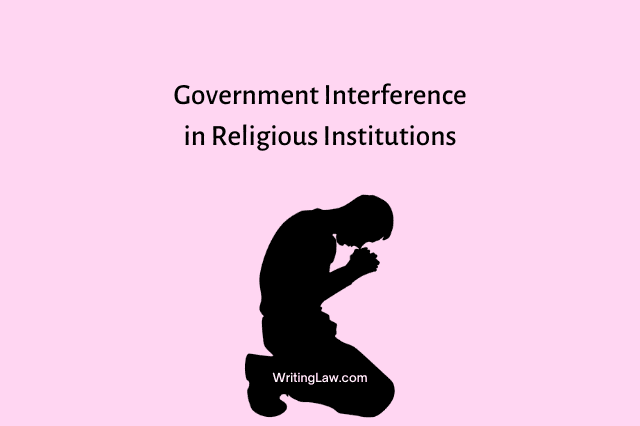
India is a secular country, meaning the government keeps its distance from religion. However, it is also a very diverse nation. People from major religions, like Hindus, Muslims, Christians, Sikhs, Jains, Parsis, Buddhists, Jews, etc., live here.
Religion plays a vital role on all social, economic, and cultural fronts. So, the government is bound to regulate and interfere in the realm of religious coherence to maintain peace and order in society. However, it should do so while preserving the secular ideals of the country and the religious freedom guaranteed by the Constitution.
This law article primarily focuses on the extent to which the government can interfere in the affairs and administration of religious institutions in India.
What Are Religious Institutions?
Section 2(f) of the Religious Institutions Act, 1988 defines a “religious institution” as an institution for the promotion of any religion or persuasion. It includes any place or premises used for public religious worship by whatever name or designation known. This definition is wide and includes Temples, Churches, Mosques, Mutths, Synagogues and Viharas.
The Concept of Secularism in India
Secularism is the separation of religion from the political, democratic, social and economic aspects of the state. However, it can have multiple meanings across the world. This is because secularism can vary according to the local conditions of each country.
For instance, in countries like France and USA, secularism is the complete elimination of religion from politics. The government has no say in religious affairs.
But in a country like India, it is not easy to separate religion from the state. Religion and spirituality have always been part and parcel of Indian society. The framers of the Indian Constitution were well aware of this. They also knew that in order to carry out certain social reforms in independent India, the government had to interfere in religion.
For example, when they incorporated Article 17, they knew that the government would have to interfere in Hinduism to abolish untouchability. Hence, Indian secularism is not secularism in the strict sense. It is the principled distance of religion from the state and not a strict separation of religion from the state. This means that there is more scope for the government to interfere in religion and religious institutions in India in comparison to that of countries like the USA and France.
Does Government Interference in Religious Institutions Violate the Religious Freedom Guaranteed by the Constitution?
The Constitution of India has guaranteed individuals the freedom of religion as a Fundamental Right. Articles 25 to 28 deal with religious freedom. Article 25 and Article 26 deal with the freedom to practice one’s religion and the freedom to administer religious affairs. Any government intervention in religious institutions which infringes upon these rights will be unconstitutional.
Article 25
Article 25 states that everyone is free to profess, propagate and practice their religion. However, this right is not absolute. It is subject to the following limitations:
I. Public Morality, Health and Public Order
For instance, the government ordered the closure of all religious institutions following the outbreak of COVID in the light of public health.
II. Exceptions in Article 25(2)
The first exception in Article 25(2) allows the government to make a law regulating any financial, political or other secular activity associated with religion. The administration of religious institutions falls within the ambit of this exception. Hence, the state is empowered to make a law regulating the administration of religious institutions, including the appointment of a board, trust or officials to manage the institution. It can also call for a report on the funds owned by the institution and appoint officials to manage and audit such funds.
In Shri Jagannath Temple Puri Management Committee vs Chintamani Khuntia, AIR 1997 SC 3839, it was held that:
“All the activities, in or connected with a temple, are not religious activities. The management of a temple or maintenance of discipline and order inside the temple can be controlled by the State by proper legislation. A law that is enacted for taking over the management of a temple is not violative of Article 25 or Article 26 of the Constitution.”
Another exception to religious freedom in Article 25(1) is provided in Article 25(2)(b). This exception allows the government to make any law for social reform and welfare and to throw open Hindu temples to all. Such a law will not be invalid even if it restricts religious freedom in Article 25.
Article 26
Article 26 provides freedom to establish religious institutions, manage religious affairs and acquire and administer property for religious purposes. However, the freedom to manage religious affairs does not include the freedom to manage religious institutions. It only includes the freedom to decide the rituals, ceremonies and practices that are to be followed. Moreover, the government is also empowered to acquire land belonging to religious institutions for public purposes like laying down roads, railways etc. Hence, the freedom to acquire and administer property is also not absolute.
Laws That Allow Government Control Over Religious Institutions
There are laws by the central as well as state govt governments that exercise control over religious institutions.
Laws by the Centre
The parliament has enacted certain laws to bring about uniformity in the administration of religious institutions all over the country. Here are some of them.
1. The Hindu Religious and Charitable Endowments Act of 1959
This Act was originally passed in British India in 1927. The British realised that adopting a policy of non-interference in religion was not feasible in a country like India. Mismanagement and misappropriation of temple funds were becoming very common in that era. Hence, the government tried to curb such activities by passing this Act. However, the application of this Act was restricted to the Madras region alone. The Madras region covered a major portion of South India in the British era. The Act currently applies to the state of Tamil Nadu alone.
2. The Wakf Act of 1995
A Wakf is a perpetual dedication of a property owned by a Muslim for religious or charitable purposes. It is managed by a person known as Mutawalli.
The Wakf Act was passed to regulate Wakfs, the transfer of Wakf property and its funds. The Act consists of nine chapters. Chapter II mandates state governments to carry out a survey and maintain lists of Wakfs.
Chapter IV deals with the establishment of the Wakf board and the appointment of its members. Chapters VI and VII specifically talk about the finances and audit of Wakfs. Chapter VIII enlists the remedies available if there is a contravention of the Act. Section 96 states that the central government has powers to regulate the secular activities of the Wakf. Hence, the Act provides for effective government control over Wakfs without infringing upon Articles 25 and 26.
Laws by the States
Almost every state has a law to regulate religious institutions. Some of them are discussed below:
1. The Tamil Nadu Hindu Religious and Charitable Endowments Act of 1959
As compared to other states, the direct control by the state in Tamil Nadu is of the highest order. This state control is through government officers. All such officers, like commissioners, hold vast powers with regard to the administration of Hindu religious institutions.
2. The Andhra Pradesh Charitable and Hindu Religious Institutions and Endowments Act of 1987
Chapter III of the Act deals with the provisions relating to the administration and management of charitable and Hindu religious institutions and endowments.
In Digyadarshan R.R. Varu vs the State of Andhra Pradesh, the Andhra Pradesh Charitable and Hindu Religious Institutions and Endowments Amendment Act of 1966 was held to be constitutionally valid.
In Gedela Satchidananda Murthy vs D.C., Endowments, it was held that the amended Andhra Pradesh Charitable and Hindu Religious Institutions and Endowments Act of 1987 is constitutionally valid.
3. The Rajasthan Public Trusts Act of 1959
Under this Act, the state government is empowered to appoint an officer known as Devasthan Commissioner. The state can also appoint Assistant Devasthan Commissioners and other subordinate officers and servants. An advisory board called the “Rajasthan Public Trust Board” is constituted to monitor the functions of Devasthan Commissioners.
4. Maharashtra Public Trusts Act of 1959
This Act was passed to regulate all religious institutions within the state. It defines a religious institution as any premise devoted exclusively to worship. It then deals with the appointment of Charity Commissioners, Deputy, Assistant and Joint Charity Commissioners who monitor the functioning of religious institutions.
5. The Shri Jagannath Temple Act of 1955
This Act came into force only in 1960. It transferred most of the administrative functions to the Shri Jagannath Temple Managing Committee constituted by the government. Only nominal functions remain with the royal family of the Raja of Puri.
6. The Kerala Madrasa Teachers Welfare Fund Act of 2019
This Act was passed very recently to regulate the salaries and pensions of teachers in Madrasas. It is currently under challenge in the High Court of Kerala.
Case Law
The Commissioner, Hindu Religious Endowments, Madras vs Sri Lakshmindra Thirtha Swamiar of Sri Shirur Mutt, AIR 1954 SC 282
In this case, it was held that in the case of a religious trust or institution under a trust, it is to be ensured that religious trusts and institutions are properly administered. The state can control the secular administration of religious institutions, and such an object must be enunciated in the legislation that enables state control. In such circumstances, the state must ensure that the income of the endowments attached to the religious institutions are properly used and duly appropriated for the purposes for which they were founded or exist.
This was also the case where the doctrine of essential religious practices was first suggested. This means that only those practices that form an integral part of a religion are to be protected under Articles 25 and 26. Those that are not can be regulated by the government.
Conclusion
It is evident that the Constitution of India, along with other central and state legislations, allow government interference in religious institutions. However, Articles 25 and 26 act as watchdogs to prevent excessive government control, which may destroy the essence of the religion itself.
For instance, the government may regulate the appointment of servants and priests to a temple, but it can not dictate how the priest should conduct rituals and ceremonies.
Hence, government interference in religious institutions is allowed. But the government should always remember that secularism and religious freedom should also be preserved.
Read Next:
1. Offences Relating to Religion Under IPC
2. What Are the Differences Between Sin and Crime?
3. What Is the Places of Worship Act, 1991 and Its Objectives?








